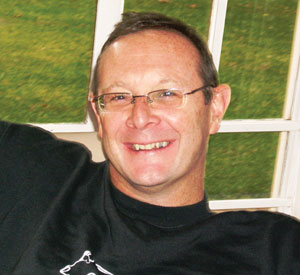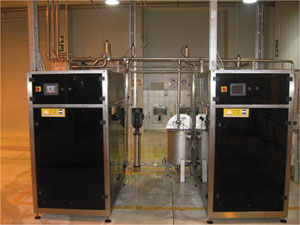Engineering R&D
UV gets ‘green’ light for disinfecting liquids
The process, developed specifically to deliver food-grade solutions for ingestible liquids and ingredients, treats turbid as well as clear liquids.

Microorganisms in milk, beer, water, fruit juices, wines and nectars, such as spoilage and pathogenic bacteria, protozoa, viruses, algae, yeasts and molds, have typically been reduced through chemical processes with additives or preservatives, thermal techniques such as pasteurization or laminar-flow UV systems.
Now a novel approach in liquid purification is being offered by SurePure of Cape Town, South Africa, using ultraviolet light in conjunction with turbulent flow to reduce the germicidal content in consumable liquids or liquids used in processing. The process, developed specifically to deliver food-grade solutions for ingestible liquids and ingredients, is said to be the first in the world to treat turbid as well as clear liquids.
The company offers SurePure UV-C, a low-maintenance, non-fouling, self-cleaning beverage processing system that delivers process and energy benefits while allowing beverage suppliers to meet growing consumer demand for products free of additives and preservatives.This approach delivers a significant reduction in microbial load while the non-thermal aspect of the process means the treated product retains all of its natural nutritional value. Certain organic contaminants and toxins also can be removed, resulting in products with a more natural taste and color. No known toxic or significant, non-toxic byproducts are formed during the treatment of liquid products with the SurePure technology.
The non-chemical, pressurized cold pasteurization process treats liquidat varying viscosities and temperatures, says Steve Miller, chief marketing officer and vice president of marketing and sales. The treatment is performed at low temperatures and is considered a non-thermal disinfection method. It eliminates all psychotrophic and thermoduric microorganisms.
Miller holds a bachelor of arts honors degree from Rhodes University, Eastern Cape, South Africa. Before joining SurePure, he was group brand executive at AVI Limited of Johannesburg, South Africa. He was previously employed for seven years by Unilever in South Africa, where he became marketing manager.

|
|
Stephen Miller, chief marketing officer and vice president marketing and sales for SurePure. Source: SurePure. |
FE: What are the benefits of the SurePure UV-C liquid photo purification process compared to heat-based or chemical processes?
Miller:Thermal processes such as pasteurization can deleteriously impact crucial nutritional, biochemical and sensorial attributes of the product. In addition, the significant process energy consumption impacts negatively on the carbon footprint of the product, and the processing equipment ties up capital unnecessarily.
Chemical additives such as preservatives are expensive, and can likewise impact the liquid’s key features. Physical filtering of fluids to remove pathogens entails expensive equipment and replaceable filters, as well as stripping out flavor, color and nutritional value.
The SurePure system can extend shelf life and shelf stability in traditionally preserved and unpreserved products, and it can enable the production of aseptically packed, preservative-free concentrates. Processing costs, which include heat, water consumption, preservatives and additives, are reduced.
FE: Why rely on UV?
Miller: The use of ultraviolet light in a specific range of the electromagnetic spectrum for the purpose of product disinfection combined with well-developed turbulent flow of the liquid are critical to our success. The wavelength for UV processes ranges from 100 to 400 nm. While UV-A [315-400 nm] is responsible for changes in human skin that lead to tanning, and UV-B [280-315 nm] can cause skin burning and skin cancer, UV-C [200-280nm] works in what is widely considered and called the germicidal range since it effectively inactivates contaminating organisms including bacteria, parasites and viruses.
FE: What does UV-C do for the process?
Miller:Liquid photo purification uses UV-C to inactivate only the DNA of the pathogen in the liquid. It is a far more benign form of purification as it largely leaves the nutrients such as enzymes, proteins and minerals intact; it impacts only those microorganisms that contain DNA, leaving the true nutritional and sensorial value of the raw liquid.
Because there is no heat involved, there is also significantly less degradation of product attributes such as color and flavor. Not only does this deliver a better consumption experience, it also allows processors to reduce expensive flavor and color additives to beverages.
FE: How does UV work as a germicidal agent against microorganisms?
Miller: The cellular DNA of the microorganism specifically absorbs ultraviolet radiation in the UV-C wavelengths. This damages the DNA of exposed cells by causing peptide bond formation in the DNA of the microorganism. The microorganism becomes reproductively inactive and unable to replicate with no residual effect, and is harmless to consumers. SurePure employs UV-C light at the wavelength of 254 nm at sufficient energy and duration to inactivate the microorganisms and disinfect the surface of liquid food products. UV-C dosage is a function of the time of exposure of the product and the intensity of the UV-C source. Different bacteria require different dosage levels of UV-C to be inactivated.

|
|
Use of ultraviolet radiation in place of pasteurization or chemicals in the reduction of microorganisms in liquids is an environmentally friendly aspect of SurePure’s liquid photo purification system. Source: SurePure. |
FE: What are the other benefits of the SurePure approach?
Miller: One of the biggest benefits is obviously the much reduced energy requirement to run this process compared to thermal processing. In some applications, this saving can run to 97 percent of the equivalent heat process. Plus, this system has no moving parts and few consumables, making it simple and inexpensive to operate consistently and reliably, either in batch or continuous processes.
FE: How does the SurePure process handle and treat liquid?
Miller: The key to the success of the SurePure technology is the patented Turbulator unit—a central and critical device in the photo purification unit—through which the liquid is exposed to the UV-C light source for consistent and repeatable operation and result. A Turbulator has a low-pressure UV germicidal lamp [30 UV-C Watt output] operating at 254 nm wavelength, encased by a quartz sleeve. Liquids are pumped through a chamber under pressure and at high flow rate, creating a thin film that experiences turbulent flow. The thin film of liquid passes uniformly over the surface of the quartz sleeve where it is exposed to the UV-C photons. A SurePure unit may feature one or many Turbulators in series to achieve the desired product treatment.
FE: How effective are the process and equipment in reducing microorganisms?
Miller: For milk producers, the photo purification process can be used as an alternative to pasteurization and can be applied either to lower the microbial counts after milking to improve milk microbial quality during transportation or to reduce post pasteurization contamination. It reduces microorganisms without causing oxidation in milk or impacting the protein, fat, lactose or vitamins in milk. Log reduction is dependent on dosage, the liquid treated and microbial content.
FE: How does the SurePure process handle oxygen stability, a concern with wine?
Miller: Red wine has phenolic compounds that absorb UV light [at 254 nm], but the SurePure closed and pressurized system has no place for oxygen to enter it. Hence, wine cannot be oxidized during treatment, and the system has no change or effect on the phenols, alcohol or extract, reducing sugar, pH and volatile acidity present in the wine.
FE: What is the state of commercialization of the process?
Miller: SurePure systems are in use globally in a number of brewing, juice and dairy production facilities. Additionally, a number of trial sites are in operation in conjunction with our global distributor network. The SurePure photo purification process was recently approved as an alternative to milk pasteurization in India. Additionally, a published report indicated the technology could be an alternative to thermal pasteurization of human breast milk for milk banks in hospitals. Success has been had in the brewing industry where significant power and water saving have been realized. Our company presented its technology earlier this year at the Fortune Brainstorm Green conference where five companies are selected to present their ideas to potential international investors. A video of the process can be viewed on www.surepureinc.com.
Looking for a reprint of this article?
From high-res PDFs to custom plaques, order your copy today!







